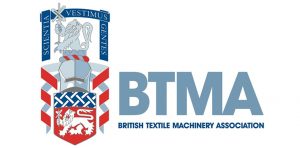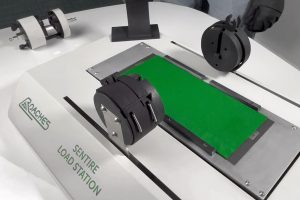 MANCHESTER, England — June 10, 2025 — A leading position in the areas of testing, instrumentation and machine control has been established by members of the British Textile Machinery Association (BTMA) and a number of new developments in these fields will be showcased at this year’s ITMA Asia + CITME exhibition, which takes place in Singapore from October 28-31.
MANCHESTER, England — June 10, 2025 — A leading position in the areas of testing, instrumentation and machine control has been established by members of the British Textile Machinery Association (BTMA) and a number of new developments in these fields will be showcased at this year’s ITMA Asia + CITME exhibition, which takes place in Singapore from October 28-31.

“Many of our members are currently developing new technologies, either in-house or increasingly through joint projects, and there will be much to reveal by the time of ITMA Asia in Singapore,” says BTMA CEO Jason Kent. “Some of the most recent developments are really going beyond what has previously been possible.”
The tactility challenge
A case in point is the new Sentire fabric handle tester which has just been launched by Roaches International.
One of the biggest challenges faced by designers and manufacturers, the company explains, is in describing and sharing information about fabric aesthetics before manufacturing, or without the costly and time-consuming process of transporting physical samples.

The elusive concept of ‘fabric handle’ – the tactile sensation experienced when touching and manipulating fabric – is a critical aspect of textile evaluation, but to date it’s been very subjective.
“No two people will describe how a fabric feels in the same way and the lack of a common language to describe fabric tactility poses communication challenges across the complex global fashion and textile supply chain,” says Roaches
International MD Sean O’Neill. “How do you objectively measure qualities like softness, smoothness, drape, and stiffness?”
The answer is with the new Sentire
Haptic spatial system
Roaches worked with specialists at the University of Leeds to develop the new finished fabric evaluation system which defines the tactile properties of fabrics via a haptic spatial system – similar, for example, to the way colour charts are digitally defined for colour palettes, or Tog values rate warmth.
Fabric samples are placed into the Sentire to run a series of tests which generate quantitative fabric tactile property data akin to a fingerprint for the fabric, which can then be compared against other samples and communicated digitally to partners in different locations.
“This technology has the potential to impact the supply chain in a similar way to the spectrophotometer for the communication of colour,” says O’Neill. “We have had a fantastic initial response to the Sentire and its possibilities are huge. Not only can it be used to compare textile tactility globally, but we are also seeing interest from online retailers who want to accurately display the way a particular fabric drapes on the body.”

Patterned fabric inspection
The precise detection of defects during the production of fabrics has meanwhile recently been significantly advanced with the introduction of the latest WebSpector automated fabric inspection system by Shelton Vision.
Building on its market leading vision system for plain, single colour textiles, Shelton’s patent-pending image processing techniques now recognise and adapt to complex patterns such as camouflage and even on fabrics with significant distortion and deformation.
Fabrics are not rigid and can be sheared or stretched while also being subject to local distortion, but the WebSpector system now successfully deals with such anomalies in real time to provide a reliable inspection process at the same levels as plain fabric.
The unique and advanced software techniques ensure a totally clean image, allowing the full detection of faults on fabrics running at high speeds.
WebSpector systems have already been supplied to manufacturers of performance wear and high-end fashion, automotive interiors, denim, outdoor upholstery, sunscreen, mattress ticking, window dressings and even carbon fibre composites.
The latest Webspector was introduced at ITMA 2023 in Milan to great acclaim and will be demonstrated for the first time in Asia at the Singapore exhibition.

Abrasion and pilling testing
Martindale testing needs little introduction to textile manufacturers, being well established as the industry standard for abrasion and pilling testing since its initial development and introduction by James Heal back in the 1940s.
For 2025, however, James Heal’s development team have taken a fresh look at this classic instrument and the result is the new Martindale Motion.
This redesigned nine-station Martindale instrument with individual lifting heads now offers the flexibility to run each station independently for carrying out different textile tests simultaneously.
Multiple textiles can be tested at the same time through to conclusion without intervention. Once set up, the Martindale Motion can be left running with the sample holders automatically lifting at the required evaluation points, freeing up the operator’s time to do other work without the need to return until the abrasion or pilling test is fully completed, including overnight.
Each sample is kept in-tact at the end point for evaluation and checking, reducing queries on grading and the potential need for re-testing. Further refinements include a new hinged access to change the self-aligning drive pins, allowing quick and safe switching between tests.
Designed and manufactured in the UK, the James Heal Martindale range has seen numerous updates, models and innovations over the years, such as touchscreen and user-friendly software, best-in-class safety features combined with the signature near silent running of this staple lab instrument. Added to this have been the introduction of the DurAbrasion multi-function testing machine, later followed by the market-leading evolution, the AquAbrasion wet abrasion tester launched in 2019.
The Martindale Motion, however, is now taking productivity and efficiency to a higher level than ever before.
Pushing the boundaries
“These BTMA companies continue to push the boundaries of what’s possible in the area of textile testing,” says Jason Kent in conclusion. “They are each making solid contributions to the quality and performance properties of today’s textile products, and just as importantly, enabling manufacturers to prove their claims. We look forward to meeting customers old and new in Singapore.”
Founded in 1940, the British Textile Machinery Association actively promotes British textile machinery manufacturers and their products to the world. The non-profit organisation acts as a bridge between its members and the increasingly diverse industries within the textile manufacturing sector.
Posted: June 11, 2025
Source: The British Textile Machinery Association (BTMA)




